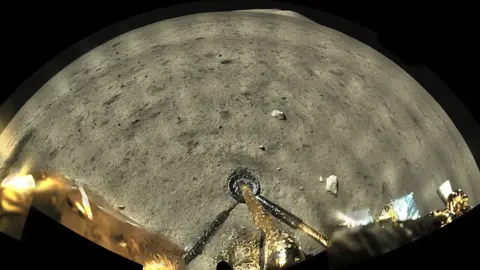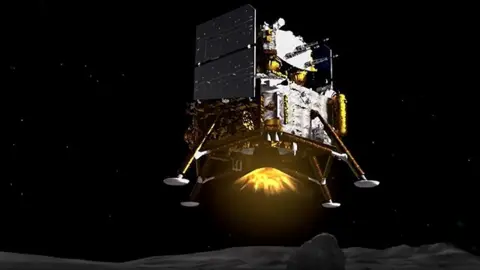China's Chang'e-5 Moon mission returns colour pictures
 CNSA/CLEP
CNSA/CLEPChina's Chang'e-5 mission has sent back its first colour photos from the surface of the Moon.
Its lander captured a panoramic view that stretches from the lunar "soil" directly under its legs all the way out to the horizon.
The mission touched down on Tuesday and immediately began gathering samples of rock and dust to send back to Earth.
These will be despatched up to an orbiting spacecraft which will shepherd them home.
This could happen as early as Thursday.
Allow X content?
Chang'e-5 is the third Chinese mission to make a soft landing at the Moon in seven years.
The two previous ventures - Chang'e-3 and Chang'e-4 - both put down static landers and small rovers.
This latest endeavour is altogether more complex, however.


An 8.2-tonne spacecraft "stack" was launched from Earth just over a week ago. The multi-module probe then split in two after going into orbit around the lunar body at the weekend.
One half - a lander and ascender - went down to the surface; the other half - a shepherding service vehicle and atmospheric re-entry module - stayed aloft.
The lander is now using its instruments, a scoop and a drill to identify and collect the best lunar samples. And once this operation is complete, the materials will be blasted skyward in the ascender to meet up with the orbiting components.
The rock and soil samples must then be handed over to the shepherding vehicle and re-entry module for the journey home.
 CNSA
CNSAIt's 44 years since rock and dust was last returned from the Moon.
A total of just under 400kg were picked up by American Apollo astronauts and the Soviets' robotic Luna landers.
But all these samples were very old - more than three billion years in age.
The Chang'e-5 materials should be quite different.
The mission has targeted a high volcanic region called Mons Rümker. Samples from this location may be no more than 1.2 or 1.3 billion years old, and, as such, should provide additional insights on the geological history of the Moon.
The samples will also allow scientists to more precisely calibrate the "chronometer" they use to age surfaces on the inner Solar System planets.
This is done by counting craters (the more craters, the older the surface), but it depends on having some definitive dating at a number of locations, and the Apollo and Soviet samples were key to this. Chang'e-5 would offer a further data point.
 CNSA
CNSAJonathan.Amos-INTERNET@bbc.co.uk and follow me on Twitter: @BBCAmos